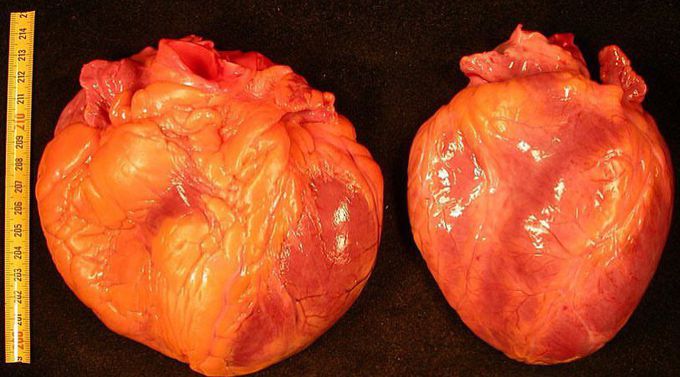


Cardiomyopathy
Big bulky heart!! Heart of a deceased patient due to dilated cardiomyopathy (left) and that of a subject without this disease! This very large heart has a globoid shape because all of the chambers are dilated. It felt very flabby, and the myocardium was poorly contractile. This is an example of a cardiomyopathy. This term is used to denote conditions in which the myocardium functions poorly and the heart ventricles is large and dilated, but there is no specific histologic finding. The impaired contraction and systolic function of one or both ventricles may lead to an overt heart failure. The disease is considered idiopathic if primary and secondary cardiomyopathy can be caused by plenty of reasons, most commonly secondary to chronic artery disease or ischemia, as well as acute viral myocarditis (notably Coxsackievirus B), heavy alcohol usage, doxorubicin adverse effect, and it is becoming increasingly common among HIV patients. Regardless of the cause, the myocardium dilates, thins, and hypertrophies in compensation, often leading to functional mitral or tricuspid regurgitation and atrial dilation. During the acute phase, the ventricle is just mildly dilated and may be normal in size because compensatory dilatation has not yet developed. In the chronic phase, with progressive dilatation the ventricles assumes a more spherical shape. Because poor prognosis and sudden death due to malignant ventricular tachyarrhythmias is typical, patients become candidates for heart transplantation.
Cardiomegaly it's the condition of the heart but here cardiomyopathy is a disease so there is different from both
Living with HIV was one of the hardest experiences of my life. The fatigue, the emotional toll, and the uncertainty about the future weighed on me every single day. I had tried many treatments and medications, but nothing seemed to restore my health or energy the way I hoped.Out of both hope and desperation, I came across NaturePath Herbal Clinic. At first, I was skeptical but something about their natural approach and the powerful stories I read gave me the courage to try one more time.I began their herbal treatment program, and within a few weeks, I noticed small but meaningful changes more energy, better sleep, and a stronger immune system. Over the months, those improvements only grew. Today, I can truly say my life has changed. I feel healthier, more balanced, and finally in control of my well-being again.This isn’t just a testimony it’s a heartfelt recommendation to anyone living with HIV or any chronic condition. Don’t give up hope. I’m so grateful I gave NaturePath Herbal Clinic a chance. Visit their website to learn more: www.naturepathherbalclinic.com Email: info@naturepathherbalclinic.com
Hemodynamic stimuli&nonhemodynamic stimuliEffects of sugar on teeth



